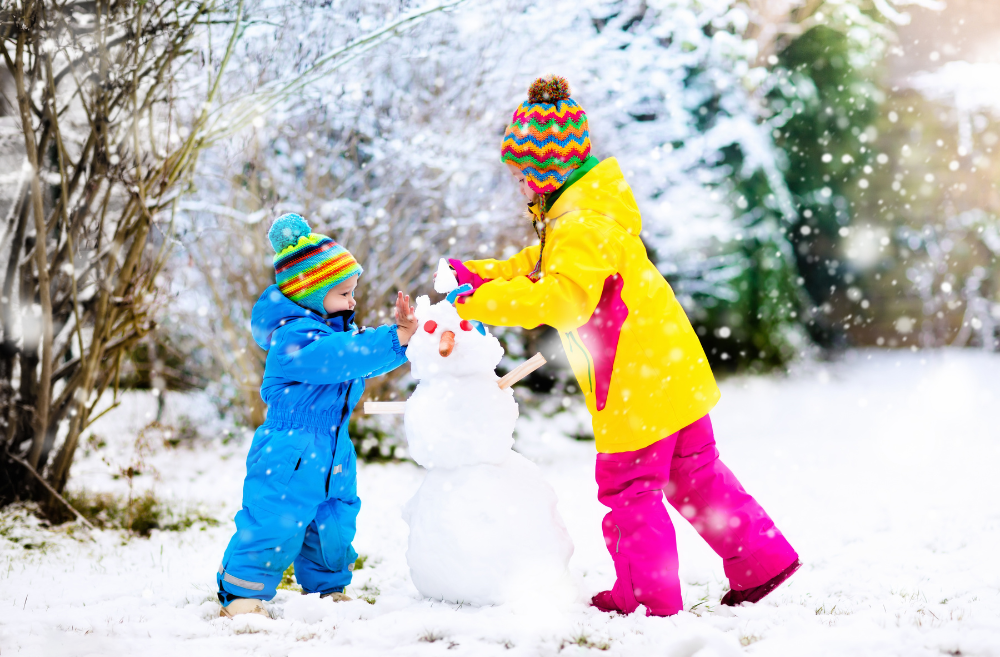Winter brings a whimsical invitation to engage in outdoor activities, and one age-old tradition stands out among the snow-covered landscapes: building a snowman. Beyond being a fun pastime, the act of creating a snowman offers a multitude of therapeutic benefits for school-aged children. Occupational therapists, physical therapists, and speech therapists recognize the profound advantages embedded within this seemingly simple activity.
Occupational Therapy: Building Skills One Snowball at a Time
Occupational therapists view snowman building as an opportunity to enhance various skills crucial for a child’s development. From fine motor skills to sensory processing, this activity engages:
- Fine Motor Skills: Rolling snowballs and assembling them into a snowman requires precise hand movements, aiding in the development of fine motor skills.
- Bilateral coordination: This is done through the use of 2 hands working together, crossing midline (incorporating both sides of the body and brain).
- Sensory Integration: The tactile experience of touching and molding snow helps children regulate sensory input, especially beneficial for those with sensory processing difficulties, such as tolerating wet or messy play.
- Planning and Organization: Designing and constructing a snowman involves following multistep directions, planning and organizing those steps, fostering cognitive skills and executive functioning.
- Cooperative play skills: This involves turn-taking, sharing, emotional regulation with peers, and observing personal space.
Physical Therapy: Snowman Building for Strength and Coordination
Physical therapists recognize the physical benefits embedded in this winter tradition:
- Strength and Endurance: Packing and lifting snowballs to form a snowman can improve whole-body muscle strength and endurance, promoting overall physical health.
- Balance and Coordination: Balancing while rolling snowballs and maneuvering through the uneven terrain of snow piles assists in enhancing coordination and balance, crucial skills for physical development.
Speech Therapy: Snowman Stories and Communication Skills
For speech therapists, the snowman-building process offers opportunities for language and communication development:
- Narrative Building: Encouraging children to describe their snowman-building process helps in developing narrative skills, and fostering storytelling abilities.
- Vocabulary Expansion: Naming different snowman parts and discussing their features enhances vocabulary and language comprehension.
- Social Interaction: Collaborating with peers to build a snowman facilitates social skills, including turn-taking, sharing ideas, and problem-solving.
Parental Guidance: Maximizing the Therapeutic Potential
As a parent, engaging your child in snowman building can be a catalyst for holistic development. Here are some suggestions:
- Provide Tools: Offer gloves, shovels, and other tools to facilitate snow manipulation and ensure warmth.
- Encourage Creativity: Allow your child to explore their imagination when designing the snowman, fostering creativity and self-expression.
- Celebrate Achievements: Acknowledge their efforts, fostering confidence and a sense of accomplishment.
- Engage in Conversation: Ask open-ended questions about their snowman-building experience to stimulate language development.
Building a snowman is not just a seasonal activity but a therapeutic endeavor that nurtures various aspects of a child’s development. From refining motor skills to fostering communication and social interaction, therapists recognize its multifaceted benefits. As parents, embracing this winter tradition can be a delightful way to support your child’s growth and well-being while creating cherished memories.
So, next time the snow falls, consider venturing out with your child to build a snowman, knowing that beyond the fun, you’re nurturing their development in countless ways.

